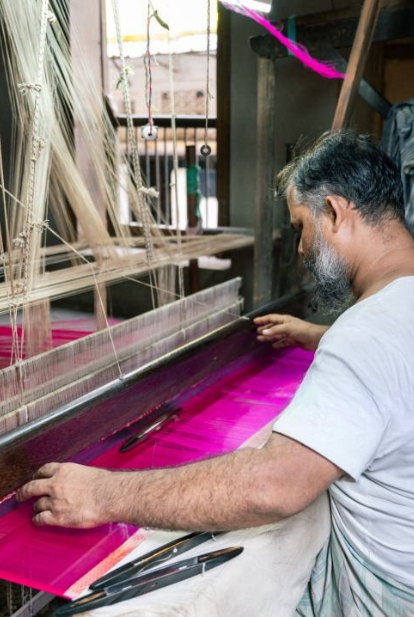From Weavers to Wardrobes The Journey of a Handwoven Fabric
The Ancient Roots of Handloom

The story of handloom weaving begins over 5,000 years ago, when early civilizations first twisted plant fibers into thread. In India, this craft became an art form - with each region developing its own signature weaves, from the delicate muslins of Bengal to the vibrant ikats of Odisha.
Today, at Weavehand, we keep these traditions alive while bringing handloom into modern wardrobes. But how does raw cotton transform into the beautiful fabrics you love? Let's follow the remarkable journey.
1: From Cotton Fields to Yarn
Our process begins with:

- Natural fibers - Cotton, silk, linen or wool
- Ethical sourcing - Direct from Indian farmers
- Hand-spinning - Using traditional charkhas (spinning wheels)
Weavehand Difference: We use only organic, pesticide-free cotton that's gentler on skin and earth.
2: The Art of Natural Dyeing
Before weaving comes color:

- Plant-based dyes - Turmeric (yellow), indigo (blue), madder root (red)
- Zero chemical runoff - Unlike synthetic dyes that pollute rivers
- Unique shades - Small batches mean subtle color variations
Fun Fact: It takes 100kg of indigo leaves to dye just 1kg of yarn!
3: The Loom Comes Alive
This is where magic happens:

- Handloom weaving - Each thread placed with precision
- Time-honored techniques - Passed down through generations
- Human touch - You can see the artisan's care in every piece
Weavehand Spotlight: Our master weaver Rajesh takes 3 days to create one saree - machines make 50 in the same time, but lack the soul.
4: From Workshop to Wardrobe
The final steps before reaching you:

- Hand-finishing - No harsh chemical treatments
- Quality checks - Every piece inspected with care
- Sustainable packaging - Cloth wraps instead of plastic
Customer Story: "My Weavehand kurta gets softer with every wash - like it's alive!" - Priya, Mumbai
Why This Journey Matters
When you choose handwoven:

- You preserve heritage crafts at risk of disappearing.
- You support fair wages for skilled artisans.
- You own something unique - No two handloom pieces are identical.
Final Thought:
Next time you wear a handwoven piece from Weavehand, remember: you're not just wearing fabric - you're wearing someone's lifetime of skill, months of careful work, and centuries of cultural wisdom.
Want to bring this beautiful journey into your home? Explore Weavehand's collection today.




